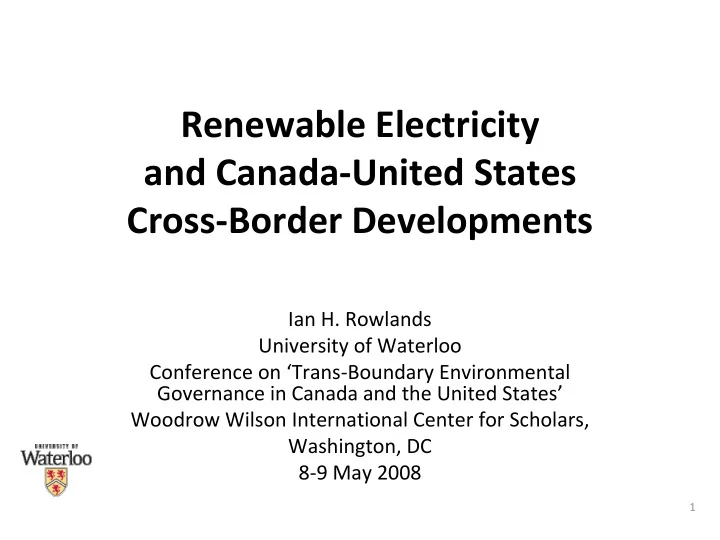

Renewable Electricity and Canada ‐ United States Cross ‐ Border Developments Ian H. Rowlands University of Waterloo Conference on ‘Trans ‐ Boundary Environmental Governance in Canada and the United States’ Woodrow Wilson International Center for Scholars, Washington, DC 8 ‐ 9 May 2008 1
Introduction • Purpose – To investigate the ways in which efforts to promote the increased use of renewable electricity in either Canada or the United States have been affected by transnational actors, institutions and structures. sources: www.green ‐ e.org/getcert_re.shtml; www.ecologo.org; www.powerauthority.on.ca 2
Introduction • Rationale – Power sector has significant air quality impacts source: http://www.cec.org/files/PDF/POLLUTANTS/PowerPlant_AirEmission_en.pdf 3
Introduction • Outline – Context – Case study I: New England / Atlantic & Quebec • Studied in some depth: potential, history, aspiration, reality, prospects – Other case studies • Manitoba/Midwest; British Columbia/Western – Other areas – Messages for environmental governance – Summary and conclusions 4
Context • Rationale – efficiency of operations in the system • increased reliability through diversity of supply – can improve the performance of renewables in electricity systems • greater geographical diversity dampens variability • greater resource availability does the same 5
Case Study I: New England / Atlantic & Quebec • potential State Predominant Province Predominant resource (share) summer resource (share) Massachusetts Natural Gas (51%) winter Quebec Hydropower (93%) peaking ↔ Connecticut Nuclear (48%) Newfoundland Hydropower (96%) peaking New Nuclear (43%) and Labrador system Hampshire New Brunswick Oil (43%) system Maine Natural Gas (43%) Nova Scotia Coal (60%) Rhode Island Natural Gas (97%) sources: Prince Edward Wind (80%) http://www.negc.org/premiers.html; Vermont Nuclear (72%) http://www.tonto.eia.doe.gov/state; Island Natural Resources Canada 6
Case Study I: New England / Atlantic & Quebec • History of bilateral cooperation – generally • ‘ Northeast International Committee on Energy (NICE)’ of the Conference of New England Governors and the Eastern Canadian Premiers dates from 1978 – specifically • 2001 goal (Climate Change Action Plan) to reduce the carbon intensity of the electricity system • ‘energy dialogue’ focusing on ‘renewable power promotion’ 7
Case Study I: New England / Atlantic & Quebec • But the reality has been sub ‐ national priorities – In Canada PEI RPS: broader Quebec RfP: interpretation wind with ‘local content’ requirement Nova Scotia RPS: generated within the New Brunswick RPS: province EcoLogo (TerraChoice) certification 8
Case Study I: New England / Atlantic & Quebec • But the reality has been sub ‐ national priorities – In the United States New Hampshire: up to 5 MW 5/6 states have an Maine: up to 100 MW RPS … different roles of hydropower Massachusetts: none To what extent are Connecticut: extra ‐ jurisdictional up to 5 MW resources acceptable Rhode Island: … using the ‘NEPOOL up to 30 MW Generation Information System’ sources: http://www.dsireusa.org; www.iso ‐ ne.com 9
Case Study I: New England / Atlantic & Quebec • Emerging bilateral relationship of significance sources: http://bangordailynews.com/ http://www.maine.gov/portal/government/; http://www.gnb.ca/cnb/logos/index ‐ e.asp ; http://mainegov ‐ images.informe.org/mpuc/images/electricity.jpg; http://elements.nb.ca/theme/archive.htm 10
Case Study II: Manitoba / Midwestern States • Brief summary http://www.midwesterngovernors.org/governors.htm; http://mktweb.midwestiso.org/home ; http://mrets.net/ 11
Case Study III: British Columbia / Western States • Brief summary sources: http://www.wregis.org/content/view/57/49/ ; http://www.gov.bc.ca/premier/media_gallery/downloads/2007/may/07may31_pgc_arnold_gal_m.jpg 12
Other areas • Ontario – neighbours • Alberta – Montana http://www.isorto.org/; http://www.matl.ca/ 13
Messages for environmental governance • Form of governance – ‘early days’, thus predominantly ‘soft law’, for it is just coming on to the agenda – but three distinct kinds of groups having influence • Governors / Premiers making declarations • Engineers (in RTOs/ISOs) as the knowledge ‐ base (though complemented by economists/auditors in design of REC markets) • Local communities defining ‘what is green’ and how to catalyse it (through, for example, an RPS) … ideas flow internationally – analogy at the global level • still ‘soft law’, for discussions regarding the ‘International Renewable Energy Agency’ 14
Messages for environmental governance • Process of governance – traditionally, ‘policy professionals’ • encouraged by the complexity and closed nature of electricity supply systems – but this conservative industry being pressed by new challenges (e.g., environmental issues) and new paradigms (e.g., distributed generation) • driven by constituents, elected officials have a role to play, by means of collective leadership (for this issue cuts across many new domains) 15
Messages for environmental governance • Geographic scope – importance of state/provincial/ regional bodies in electricity, traditionally – nature of the commodity: ‘electricity losses with distance’ encourage this – present international organisations (through NERC) http://www.nerc.com/regional/ 16
Messages for environmental governance • Impact of governance – too early to tell – as session title suggests, ‘the next frontier’ – … but it will be critical 17
Summary and conclusions • Presenter’s contact details Ian Rowlands (519) 888 ‐ 4567, ext. 32574 irowland@uwaterloo.ca 18
Recommend
More recommend